
File Size: 4.34 MB
This is the second in a series of fact sheets that describe fish and shellfish produced in the Midwest region of the United States. (See FNR-608-W, Walleye Farmed Fish Fact Sheet.) Yellow perch have been popular among anglers for many years, and since 2002, responding to greater demand, U.S. farmers are raising perch in ponds, aquaponic systems, etc. The fact sheet also includes culinary characteristics, cooking tips and a recipe for Baked Parmesan Perch.
References:
- Pam Fuller, and Matt Neilson, 2020, Perca flavescens (Mitchill, 1814): U.S. Geological Survey, Nonindigenous Aquatic Species Database, Gainesville, FL, https://nas.er.usgs.gov/queries/factsheet.aspx?SpeciesID=820, Revision Date: 8/15/2019, Peer Review Date: 5/29/2012, Access Date: 10/14/2020
- Brown T; Runciman B; Bradford M; Pollard S, 2009. A biological synopsis of yellow perch (Perca flavescens). Canadian Manuscript Reports of Fisheries and Aquatic Sciences, 2883. 28 p.
- Hudson, J. C. and Ziegler, S. S. (2014), Environment, Culture, and The Great Lakes Fisheries. Geographical Review, 104: 391–413. doi: 10.1111/j.1931-0846.2014.12041.x
- Piavis P. Yellow perch Perca flavescens. In: Funderburk SL, Jordan SJ, Mihursky JA, Riley D, editors. Habitat requirements for Chesapeake Bay living resources. 2nd edition. Solomons, MD: Chesapeake Research Consortium; 1991. p. 14.1-14.15.
- Malison, J.A. 2003. A white paper on the status and needs of yellow perch aquaculture in the north central region. Reported prepared for North Central Regional Aquaculture Center. Available at: http://ag.ansc.purdue.edu/aquanic/ncrac/wpapers/YellowPerch11-21-03.htm








